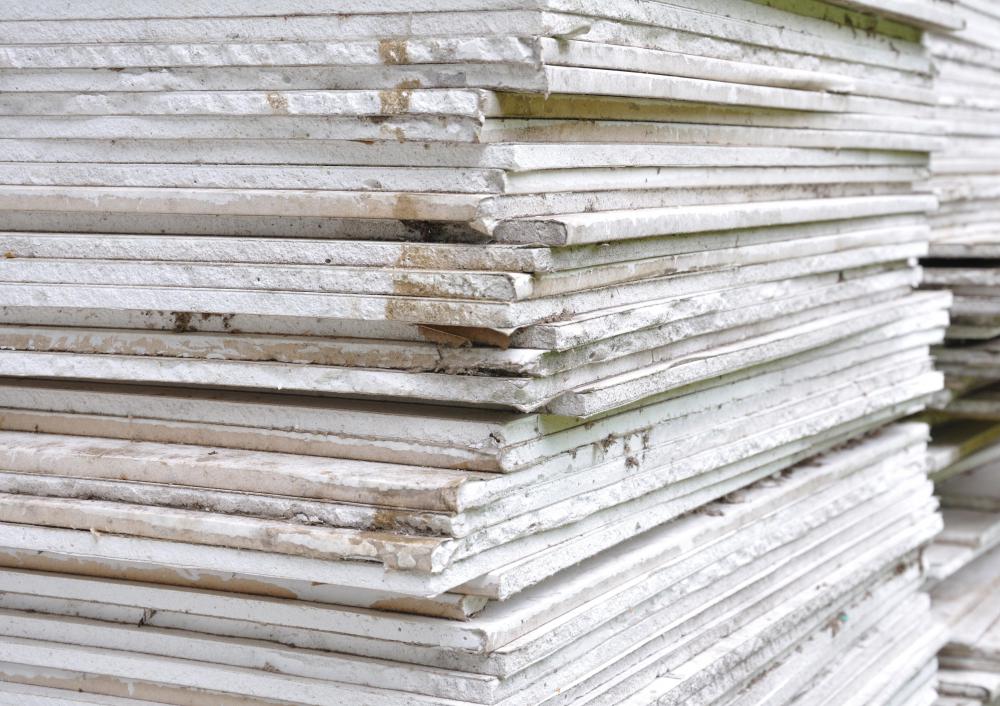At WiseGEEK, we're committed to delivering accurate, trustworthy information. Our expert-authored content is rigorously fact-checked and sourced from credible authorities. Discover how we uphold the highest standards in providing you with reliable knowledge.
What Is Green Drywall?
The term “green drywall” is typically used to describe one of two things: either drywall covered in mildew-resistant green paper, often intended for use in bathrooms or other high-humidity areas, or drywall made of environmentally sustainable materials that is green not in color but rather in terms of its footprint. Both are normally used in about the same way. Drywall no matter its composition or coating is an important part of the construction of homes and other buildings. It almost always comes in large panels that construction crews affix over the framing of a building to create smooth and closed-off walls and ceilings. Specifically green drywall is often a bit more expensive than more standard varieties, but this is usually because, under either definition, it’s something of a specialty product and is usually made to more exacting standards.
Drywall Basics

Drywall is often used when building a home to make up the interior surface of the walls and ceiling. After the walls of a building are framed in, usually with wood, large panels of drywall are then nailed or screwed to the studs. The joints are covered with a special tape, then joint compound is applied on top. In some cases the entire wall can later be given a thin coating called a “skim layer” of finishing compound, although this is not required.

Finished panels are typically painted or otherwise treated to give a more polished look to an interior. Depending on their thickness, they sometimes also offer insulation benefits that can help buildings stay either warmer or cooler, depending on the season; they do this by trapping air and preventing temperature loss moving from outside to inside. Green drywall is no exception, though it also usually provides other benefits, too.
Problems Posed by Humidity

Green drywall is commonly a synonym for green board, sometimes also written greenboard, which is a water-resistant drywall panel made with a green paper covering. In homes it is commonly used in bathrooms and kitchens where humidity tends to be high; in industry it’s also a good choice for any rooms running machinery or sealed off from fresh air that tend to grow more humid.
Regular drywall easily absorbs moisture. If installed in an area that is regularly exposed to dampness and humidity, like basements or bathrooms, it can become soft or even fall apart. Green board drywall is designed to reduce the chances of this happening. The green paper coating is, in most cases, specially treated to resist moisture. Unlike regular drywall, it should not absorb water from the air. Some companies offer green board that is also designed to be especially resistant to mold growth.
Tips and Precautions for Greenboard Use
It’s important for anyone working with green board drywall to remember that it’s only water resistant, not entirely waterproof. Although it can work well in bathrooms, it should not be installed behind showers or bathtubs, where it is more likely to get wet. In these cases, a cement backer board, such as Wonderboard®, is recommended. Green board is also not fire resistant, so it may not be a good choice for use around the stove in a kitchen.
Environmental Angle
The construction industry, like so many in the modern world, is no exception when it comes to the growing movement of “going green,” or adopting more environmentally-friendly, long-term sustainable practices. Revising and changing the composition of drywall is part of this movement, and is something that “green” construction firms often try to embrace whenever possible.
Traditional drywall is made of gypsum, and while this isn’t in and of itself problematic, in order to be effective that gypsum needs to be cooked — which in almost all cases releases carbon dioxide gas into the atmosphere. Environmentally-friendly green drywall does not use gypsum, so virtually none of the ozone-depleting carbon gas is released during its manufacturing. For that reason, it has a drastically lower carbon footprint than most other drywall products. Other environmentally friendly elements of this type of drywall are that it is mercury free, and produces no volatile organic compounds (VOCs). VOCs are gases that are emitted from certain solids or liquids that are believed to have adverse health effects.
AS FEATURED ON:
AS FEATURED ON:













Discussion Comments
Reading this article makes me very curious what green (environmentally-friendly green) drywall uses instead of gypsum. Is it a similar material, or something entirely different?
@aishia - I read that fiberglass drywall costs a lot more than regular paper drywall. When it comes to moisture resistance, I'll take the green board drywall price over the seventy percent or so price hike for the fiberglass stuff, even if it doesn't work quite as well.
The price isn't the only reason to skip fiberglass, though -- fiberglass drywall isn't recyclable. Because it's got fiberglass in it, you can't even grind it up to use it in soil like they sometimes do with the papered kind.
The mold-resistant green board is essentially paperless drywall. Instead of using paper sheets on each side of the gypsum or presumably a more "green" material in the environmental sense, this kind is made with thin layers of fiberglass.
I've worked with this kind before -- it's a lot more waterproof than the paper-covered kind, as you'd expect, but still not completely so. As the name suggests, drywall isn't meant for building places that will get downright wet, just the ones that need mold-resistance.
Post your comments